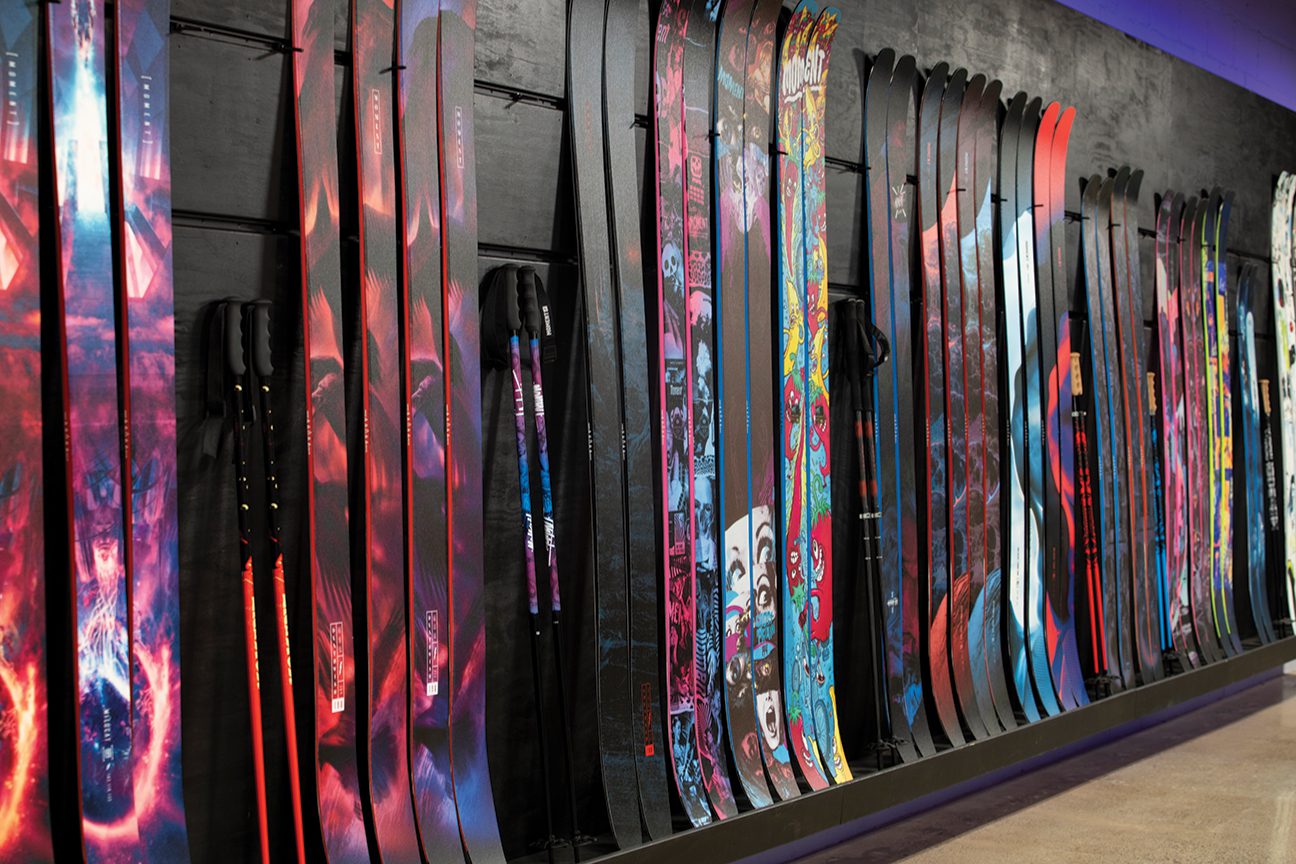
27 Nov The Biggest Little Ski Manufacturer in America
Born from necessity 20 years ago, Reno-based Moment Skis began as a fledgling startup and emerged as an innovative leader in ski design
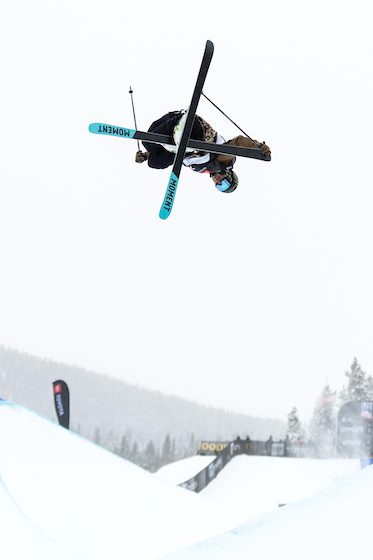
Reno-raised skier David Wise competes on a pair of Moment Skis in the 2021 Toyota U.S. Grand Prix at Copper Mountain, Colorado, photo courtesy U.S. Ski & Snowboard
In the early 2000s, skiing, at least for the younger demographic, was on life support. A generation of riders had found and slowly gravitated toward snowboarding, which was still on the ascent. The new-schoolers were drawn to the shape and flexibility of snowboards, the splashier graphics, and the ability to both float on powder and do tricks in the park.
Skiing was something your father and grandfather did. Locked at the knees, hips wiggling in unison. Bogner onesie snug at the midsection, flared at the ankles. Wine and cheese cooling in the parking lot snowbank. Apart from the increasingly rare ski bum, it was a sport defined by its own bougie and unattainable image—an experience reserved for those born with a silver spoon or the keys to the slopeside condo.
Sure, there were moments of perceived rebellion, but those also seemed a little pitch-perfect and marketing-friendly. From Glen Plake’s neon-streaked mohawk screaming down the hill to the legend of Jonny Moseley’s mute grab, skiing was the domain of the privileged sons of privileged sons.
And then came a kid from Gardnerville, Nevada.
Still fresh out of high school, Casey Hakansson appeared in a 1998 lo-fi ski porn classic called Butter—a movie for those who still loved the sport but had been left behind by it.
The film featured skier Shane Anderson, who went on to become a documentarian and environmentalist. In his shredder heyday, Anderson looked like a boy band reject, a bleach blonde Billy Idol knockoff. He could’ve been any kid at the mall wearing a
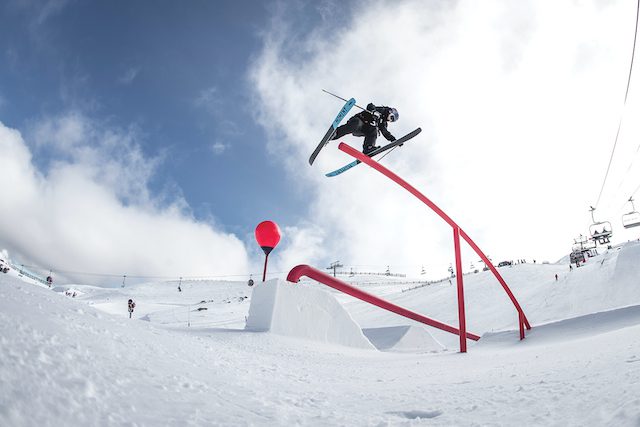
Moment Skis athlete Cody LaPlante slides a rail at the Audi Quattro Winter Games in Wanaka, New Zealand, photo by Miles Holden, courtesy Red Bull Content Pool
too-baggy collared shirt sipping an Orange Julius while working at the Sunglass Hut kiosk, fencing Arnettes on the side—all frosted tips and hopeless suburban stare.
But Anderson was something more: He was part big-mountain rider, part huckster daredevil riffing on famous ski tropes of yore—the classic jump over the High Sierra road, only this time doing it double backflip style and landing on his face—and part glimpse into the untamed immediate future of what would be.
Though the big lines in Butter were clean and plentiful and the tricks were … still being worked out, the skis were decidedly not great—long and skinny and about as flexible as the manager at your first restaurant job. At the time, it seemed that’s all there’d be. Skiing, if it was to survive, was going to have to burrow deep underground. The snowboarders had gotten the jump on what’s next—the innovation, the cool stickers and the big contracts.
A Ski Built in a Snowboard Factory
Hakansson was trying to make his way up the ranks to become a professional freerider—and he wasn’t completely satisfied with that answer. Nor did he really like what he was riding on.
No ski sponsor in the offing, he went to work. And he found the answer, not surprisingly, in snowboarding.
“My friend was making snowboards over at Sentury Snowboards (in Reno),” he told the Reno Gazette-Journal in December 2010. “Through bugging him and seeing how he did it, and just asking a bunch of questions, is how the first Moment Skis were built.”
In 2003, the first Moment ski rolled out of Sentury’s shop. The ski was a little shorter, a little wider underfoot, a little jankier overall—but it played with some of snowboarding’s sensibilities to float better on powder, yet remain nimble in the park.
The first skis weren’t a breakout hit or an overnight success story—nor even an “aha” moment: “It pretty much rode you,” Hakansson recalled of testing out his creation to the Gazette-Journal in September 2007. “And it didn’t like turning, unless you were going fast, or it was really steep.”
Moment Comes to Life
Luke Jacobson, Moment Skis’ current CEO, recalls that initial pair of skis and how it was just a one-off, a side project’s side project.
“The next pair wasn’t made till a whole year later, and that’s when I kind of heard about it,” says Jacobson, speaking from Moment’s Reno headquarters off Highway 395 less than a mile from Midtown. “Casey was still doing masonry and I was going to UNR and getting a mechanical engineering degree. But I wanted to make sides and I essentially showed up one day and never left.”
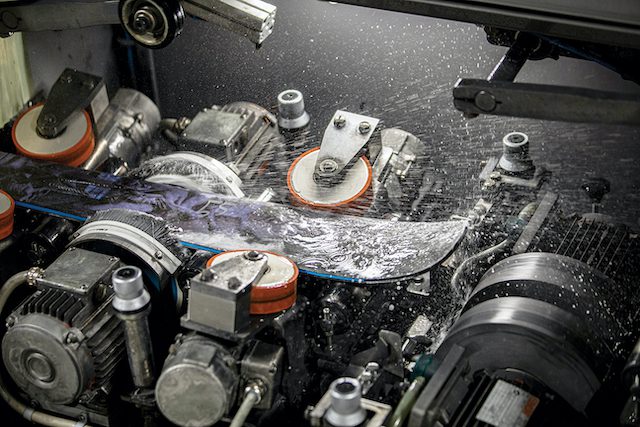
A ski goes through a machine for its final edge tune and polish at the Moment factory, photo by Ryan Salm
Jacobson describes meeting Hakansson and talking right away about the ski he’d made and maybe trying to make another pair. He refers to those early days as “a movie you’ve seen a long time ago.” It took a year for the pair to finish work on the second set of Moments.
And that’s where they thought it would end.
“There wasn’t an intention to start a ski company at that time. You know, it sounds cliché, but it was for fun,” Jacobson says, noting the second pair turned out better than the first and friends on the mountain started asking about the wider, yet more maneuverable, ski. “Skis were changing a lot, or they were starting to change, and it’s really funny, we started coming up with ideas for skis, and nobody was making them. So, we went ahead.”
Enter McConkey
At that same time, Tahoe freeskier and merry prankster-innovator GOAT Shane McConkey took a pair of waterskis from the 1970s and mounted bindings on them and decided to ride them on powder. And they worked.
“Skis are normally the fattest at the tip and get skinniest underfoot and get fat again at the tail, and these are the opposite—they’re fattest in the middle and skinnier at the top,” McConkey said. “I took that shape idea from waterspouts, from surfboards, wakeboards, waterskis.”
McConkey took the idea to Volant, a foundering Colorado-based ski manufacturer that made a metal-surfaced “cap” ski (no sidewalls). In 2002, out came the Spatula, which was the first of McConkey’s inventions to come to life.
“Everything about the Spatula was at odds with how Volant skis were made,” Powder Magazine reported in September 2009. “The ideas didn’t make sense to the engineers. The concepts were impossible to build with their existing tooling, and the company was facing a financial crisis that had everyone but [R&D manager] Peter Turner and engineer Ryan Carroll completely disinterested in pursuing McConkey’s radical line of thinking.
“It took them two years to design, engineer and build the first four pairs—all of which were done by hand, on-site in their office.”
They shipped the skis to McConkey in New Zealand in September 2001, and a few days later Turner was giving a “message [that] consisted of a string of superlatives, sprinkled liberally with F-bombs, and can be conservatively paraphrased as: ‘These are the best damn skis ever made.’”
And the powder ski was born.
Moment Takes Shape
Meanwhile, back in Reno, the Moment guys, who knew of McConkey and the Spatula, were impressed. But they also knew there was a new world opening up with ski design, one they’d somehow found themselves on the forefront of.
So, they went to work.
“I was going to school, [Hakansson] was doing masonry. We’d work super, super late, and we’d sleep at the facility,” Jacobson recalls. “It started with a second pair. Then a couple pairs for our friends. We made our own designs, we made our own machinery, including our own CNC machine [which quickly cuts materials to spec]. It was a totally different game in those days, but it evolved, fast.”
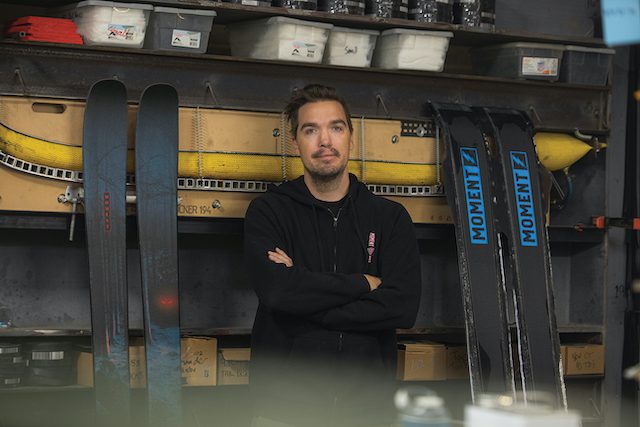
Moment Skis CEO Luke Jacobson in the company’s Reno factory, photo by Ryan Salm
It did. Everything did. By 2004, McConkey was rising to international star status. Volant had been acquired by Atomic and McConkey had switched sponsors and was starting his own line of fat skis with K2.
At the same time, the Moment guys continued to workshop and come up with a line of skis in between jobs and life.
“[Casey] was trying to do the Freeride World Tour in the winter and work this butt off doing masonry in the summer, and we were trying to make skis in between,” Jacobson says. “There really were no small ski companies that were around—just the traditional majors in Europe and China and, slowly, us.
“I remember the early days, just Casey and me, it would take us so long. We had between two and six pairs of skis done and it was such an ordeal.”
But Moment continued to grow, slowly at first. Based on feedback from friends, they started to develop their signature blunted tip style of skis that combined wide underfoot shapes that could cruise on a powder day with the park-bred ethos of twin tips and the snowboarding-centric design of having camber underfoot—an all-mountain, go-anywhere, do-anything ski with which you could jib or send or even slide down a groomer.
The company in its early stages was equal parts snarling and sincere, run by 20-somethings who had no business being in the industry that they equally admired and abhorred. They soon came up with their signature “Mustache” design (now better known as triple camber), with its rocker at the tip and tail and camber in the middle. When the ski is laid flat and viewed from the side, it looks like a Dandy Stache.
Though the devil-may-care ski bro ethos may seem an old marketing trope now, Moment’s naiveté and attitude was born from a place of necessity.
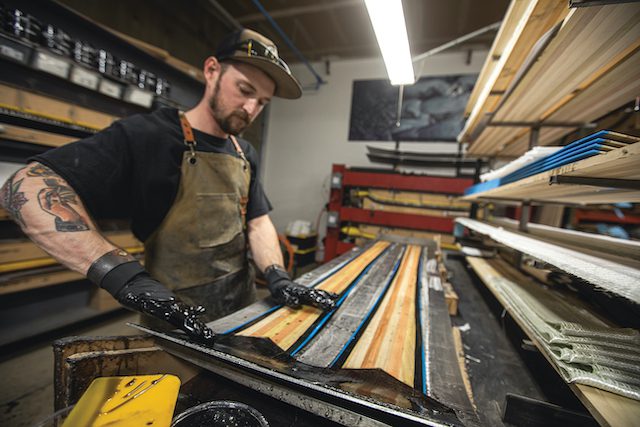
Kyle Wells assembles the raw materials needed to build a pair of Moment Skis in what is called the layup process, photo by Ryan Salm
“We were really fast and loose with financials,” Jacobson says. “We just wanted to make something different and back then … rocker wasn’t really too much of a thing. Then we started playing with front rocker and twin rocker and were the first company to make a rocker park ski, which won an award.”
Jacobson recalls loading up skis for Moment’s first SIA trade show and pointing it south on Highway 95 to Las Vegas, where they were set to have a booth next to the big boys.
“I remember, I had to tell my professors, ‘Hey, I have this company and I’m not going to be at school next week,’” Jacobson recalls, laughing. “We went down there, and we built this whole booth, and I remember thinking, ‘You know, the catalyst of us wanting to go down here is we want to let people know who we are and that we’re serious.’ And, of course, it was the morning of, and we hadn’t created a price list.”
The amateurism may have been evident in the details, but the product caught the eyes of many.
“We had major manufacturers in our booth with calipers measuring stuff out,” Jacobson says. “Some people placed some orders, and it worked. It snowballed from there. I eventually finished my engineering degree and Casey was working other jobs, too. There was a time where we were able to switch from making skis between 7 p.m. and 3 a.m. to getting some help and making this a real thing.”
Bahrke for Bronze
Between 2006 and 2010, Moment’s sales volume doubled every year and revenue shot up along with it, surpassing $1 million in 2011.
By 2010, distribution had also changed, with Moment shipping skis internationally and getting international exposure to boot. At the 2010 Vancouver Winter Olympics, Tahoe freestyle skier Shannon Bahrke, who will be inducted into the U.S. National Ski & Snowboard Hall of Fame in 2024, took home the bronze medal in moguls, smiling, hair dyed pink, her pair of Moments accompanying her to the podium.
“It was pretty funny because Casey was really good friends or had gone to school with Shelly [Robertson], my best friend on the team,” says Bahrke Happe. “She was like, ‘Dude, I don’t have a ski sponsor.’ And he was like, ‘Yeah, we can make a mogul ski.’ And I was like, ‘You don’t even know what they do, how they’re going to turn out.’”
Robertson got the skis and approached Bahrke, singing Moment’s praises.
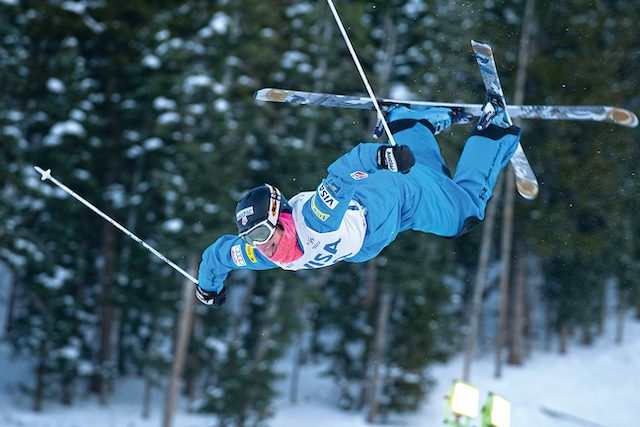
Shannon Bahrke at the Freestyle International World Cup at Deer Valley, Utah, in 2009, photo by Gary Dickey, courtesy U.S. Ski & Snowboard
“I tried them, and they were amazing. They were perfect,” Bahrke Happe says. “I love a soft ski, and it suited the way I like to ski, the way I turned my ski. It felt like those things really matched up. So, I was like, ‘Do you think I could get a pair?’ It was so natural, so incredible.”
Bahrke didn’t have a ton of time to get used to her Moments before she found herself in the starting gate in Vancouver during the moguls finals.
“We had a qualification run. It was just pouring down rain. Every piece of me was wet, soaking—gloves, helmet, neck, skis, everything. Usually in a regular World Cup it was a minute and a half between competitors, and in the Olympics it was 8 minutes, and I was running last. And I hate being last,” she recalls. “When I got in the gate, I collapsed. I skied horrible. I crossed in sixth place. All the fears … all the things that had been weighing me down came true. I was sitting in the snow with my now husband, then boyfriend, and I was like, ‘Oh my gosh, I blew it.’”
And then an unfamiliar voice from the crowd called out for Bahrke.
“She was like, ‘Can I talk to you? It’s OK, I’m a Facebook friend,’” Bahrke Happe says, laughing while retelling the story. “And it changed everything and shifted my focus to how funny that was. A Facebook friend! Who in the world does that?! But it gave me a moment to choose who I was and how I’d show up and who I wanted to be at the gate.
“I got on the chairlift and back up to the top and I was listening to Party in the U.S.A., and I saw Hannah [Kearney] and Heather McPhie, and I said, ‘Girls, we can sweep the podium.’”
It would be Kearney with the gold and Canada’s Jennifer Heil with silver, with Bahrke rounding out the podium in third—giving her another Olympic medal to go along with the silver she earned in 2002.
“I think a lot of who I am—I’ve always rooted for the underdog. I’ve been the underdog. So when I found Moment, I felt that they were the underdog too,” Bahrke Happe says. “They believed in me, and they went above and beyond for me. And I just—I can’t believe it’s been 20 years, but I know they’ll have many, many more.”
Love for Local Heroes
The Olympic cred coincided with skiing, as a sport, coming full circle—suddenly fun again—and Moment was leading the way in that category as well as innovation. The still-young company not only spawned a generation of boutique ski manufacturers, but it outgrew that label in the process. By the mid-2010s, Moment had become the largest ski manufacturer in the U.S., a title it still holds today, Jacobson says.
The company’s profile has similarly grown, perhaps culminating in recent years with Reno-raised halfpipe skier David Wise, who at the 2018 PyeongChang Winter Olympics defended his 2014 halfpipe gold on Moment Skis—standing atop the podium hoisting a pair of skis that were made right in his backyard for the world to see.
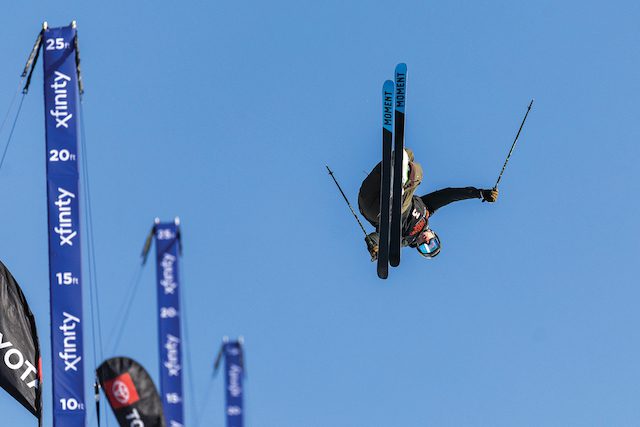
David Wise on his Moment Skis at the Toyota U.S. Grand Prix at Mammoth Mountain in February 2023, photo by Dustin Satloff, courtesy U.S. Ski & Snowboard
Even though Moment is proud of its Olympic lineage and team of professional riders—including Tyler Curle, Cody LaPlante, Carston Oliver and Eric Balken, to name a few—Jacobson says going out and finding local legends who ride hard in places like the Wasatch in Utah, Alaska, British Columbia, Australia, New Zealand and even Japan is who the company still aims to sponsor.
“There’s this guy Mark ‘Danger’ Davidson in Big Sky, Montana. He runs the town and he’s just the man,” Jacobson says. “I was skiing in Big Sky [and] he had a pair of [Moment] Governor 196s, and I was like, ‘Hey, nice skis.’ My buddy pointed to me and said, ‘This is the guy that made ’em.’ And I had a beer with him and just started sending him skis ever since.
“We love local heroes. Guys and girls who love skiing.”
Bo Brueck, a Michigan-raised skier and ski tech who made his way West and currently works at East Slope Outdoors—the last independently owned ski shop in Big Sky—says Moment Skis are the store’s top seller.
“We go through them really quickly,” he says. “Everyone that rides them loves them. They shine at Big Sky, especially. Up at Lone Peak we’ve got a lot of gnarly terrain, and a burly wood ski like in the Wildcat and Deathwish performs well all over the mountain.
“Everyone who rides Moments just comes back with a huge smile on their face. We love that. They just match our terrain really well, and they’re good for tourists and renters, as well as for people who love to tear it up off the piste. They’re a star.”
Age of Refinement
In the fall, as Moment quietly turned 20, it did so as a full-fledged, industry-leading, big company. The young upstarts who ran it are now fully entrenched in the next phase of their own lives, entering middle age and facing the challenges and changes all of that brings.
Jacobson reflects on the company’s transition in recent years. The ski business has taken a bit of a hit. Many of the small U.S. ski manufacturers that came up in Moment’s shadow did not survive the economic ups and downs of the pandemic era.
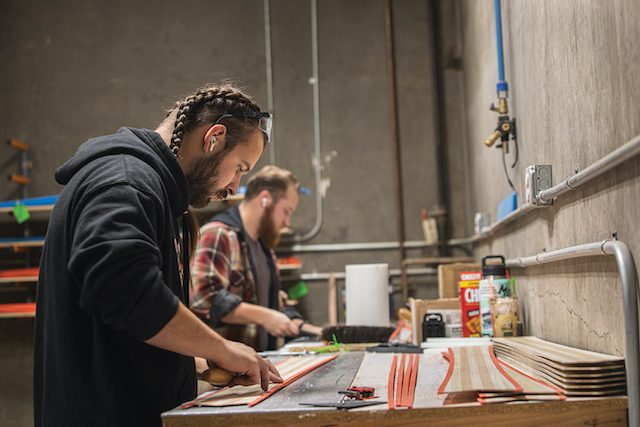
Nathan Parrish and Aidan Yamamoto attach the sidewall of a ski to the core, photo by Ryan Salm
About six years ago, Hakansson took a step back from the day-to-day operations of Moment to focus on taking over his family’s masonry business. Jacobson, the kid who skipped class to attend a trade show, now runs a multinational enterprise with supply chain issues, an HR department and professional athletes. The fast and loose financials and boozy all-nighters have been replaced by corporate responsibility and running a manufacturing company that has become the status quo.
“Fat skis and rocker and twin tips—a lot happened really fast, and a lot of really cool things all at once,” Jacobson says. “But you look at the market now, it is still changing. Now everyone has fat skis, but also you still have to have something that rips in the chop. It’s not revolutions, but refinement—that’s really what we push after.”
Moment’s current ski lineup has shrunk over the years to a trio of series (Wildcat, Deathwish and Commander), along with a more specialty Reserve Series—all manufactured on-site in Reno. The company also sells poles and bindings and has a boot fitter at the Reno factory store, so a rider can come in cold and leave completely outfitted.
What’s next? Jacobson says 20 years is a good marker in time to reflect. He admits that at some point he’d like to sit down, perhaps late at night, and crack open a beer and do just that.
In the interim, for all that’s happened, one thing remains the same from those initial pairs of skis that took so long to take shape two decades ago: “We’ve always tried to make sticks that make the days a little more enjoyable. And that never changes.”
Andrew Pridgen bought his pair of Moment Bibbys in 2011 and has been riding them ever since. Last year a liftie took a photo of them and posted it to his Instagram with the caption, “Great to see older guys w/older gear out here shredding!!”




No Comments